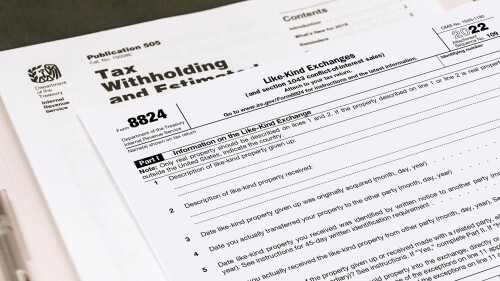Interested in
1031 Exchange
Properties?
Discover if this investment is right for you
At RealtyMogul, our mission is to empower investors to achieve their financial freedom by investing in real estate. We have added 1031 eligible properties from real estate sponsors to our list of investment opportunities.



Details matter: Work closely with your advisors to ensure you don’t trip yourself up. For example, pay close attention to withdrawals as these can be considered taxable, understand the role of “boot” and know the level of leverage on the replacement property to avoid negative surprises.
Focus on your goals: Tax deferral is important but make sure you are achieving your financial goals with the transaction and not just focused on the tax bill. Real estate investments do not come without risk and typically are illiquid investments – so make sure that a 1031 exchange is right for you.
Work with a Qualified Intermediary (QI)
Sell The Property
Identify Replacement Property
Acquire Replacement Property
Report The Exchange - Year One
Report The Exchange - Year Two
Three-Property Rule
This rule, also called the three-property identification rule, lets investors find a maximum of three “like-kind” properties that could be potential replacement properties, regardless of the fair market values. This method is popular because it allows investors to have backups.
200% Rule
According to the 200% rule, you can find unlimited like-kind replacement properties as long as the total value of the properties doesn’t exceed 200% of the total net sales value from the relinquished property.
95% Rule
With the 95% exception, you can find unlimited replacement properties and any fair market value as long as you acquire and close on 95% of the market value.
Trade or Business Property
The property must be held for investment or used in a trade or business. In order to qualify for a 1031 exchange, both the relinquished property (the property being sold) and the replacement property must be held for investment or used in a trade or business. Personal use property, such as a primary residence or vacation home, does not qualify for a 1031 exchange. Although there is no official rule regarding how long you must hold your property prior to a 1031 exchange, be sure to consult with a QI or tax professional to see if there are any timing or other conflicts preventing you from conducting a 1031 exchange.
Like-Kind Rule
The replacement property must be of “like-kind” to the relinquished property. This means that the properties must be of the same nature or character, even if they differ in quality or grade. For example, a commercial building can be exchanged for a residential rental property as long as they are both held for investment or used in a trade or business.
For more information, visit the IRS page regarding 1031 Exchange properties here.
What is a 1031 Exchange?
A 1031 exchange, also known as a like-kind exchange, is a tax-deferred transaction allowed under section 1031 of the Internal Revenue Code (IRC) that allows an individual or business to defer paying capital gains taxes on the sale of an investment property. In this type of exchange, the proceeds from the sale of the property are reinvested into a similar property of equal or greater value within a specific time frame, typically 180 days.
The exchange allows investors to defer paying taxes on the capital gains they would have otherwise incurred upon the sale of the property, provided the proceeds are reinvested in a “like-kind” property. This allows investors to avoid losing a portion of their gains to taxes and instead reinvest those gains into a new property. However, it’s important to note that there are specific requirements and guidelines that must be followed to ensure a successful 1031 exchange.
Which properties qualify for a 1031 Exchange?
To qualify for a 1031 Exchange, the properties involved must meet certain requirements:
The properties must be held for investment, business or income-producing purposes.
The properties must be of like-kind (see below)
The properties must be located within the United States.
It’s important to note that not all types of property qualify for a 1031 Exchange, such as primary residences or properties held primarily for personal use. It’s best to consult with a qualified tax advisor, Qualified Intermediary, or real estate attorney to determine if a specific property qualifies for a 1031 Exchange.
What are the main rules of a 1031 Exchange?
Like-kind property: The property being sold, and the property being acquired must be “like-kind” property(s), meaning they are of the same nature, character, or class. For example, you can exchange an investment property for another investment property, but you cannot exchange a primary residence for an investment property as the “nature, character, or class” is different. Additionally, only real property can be exchanged for real property under a 1031 Exchange. Personal property does not qualify for this type of exchange.
Qualified intermediary: A qualified intermediary (QI), also known as an Accommodator, must be used to facilitate the exchange. The QI is a third party who holds the funds from the sale of the relinquished property and then uses those funds to purchase the replacement property. If the seller takes possession of the sale proceeds, even temporarily, the exchange becomes voided, and the seller will be accountable for paying the taxes related to that sale. It is recommended to contact a QI prior to the sale of the relinquished property to ensure all rules are correctly followed.
Identification period: The taxpayer has 45 calendar days from the date of the sale of the relinquished property to identify potential replacement properties. The identification must be in writing and signed by the taxpayer.
Exchange period: The taxpayer has 180 calendar days from the sale of the relinquished property to complete the exchange by acquiring the replacement property. Note: this is inclusive of the 45-day identification period.
Reinvestment requirement: The taxpayer must reinvest all of the proceeds from the sale of the relinquished property into the replacement property to avoid paying capital gains taxes on the sale. Any portion not reinvested is subject to taxation.
Same taxpayer/tax I.D: The same taxpayer who sold the relinquished property must be the one who acquires the replacement property. The taxpayer ID must be the same on both sides of the exchange.
Equal or greater value: The replacement property(s) must be of equal or greater value than the relinquished property.
Written identification: The taxpayer must provide written notice to the Qualified Intermediary, identifying the replacement property or properties.
Property description: The identification must include a clear description of the property or properties being identified, such as the street address or legal description.
Change of identification: The taxpayer can change the identified property or properties within the 45-day identification period, as long as the replacement property or properties meet the above requirements, and the taxpayer notifies the Qualified Intermediary in writing.
It’s important to note that these rules can be complex and there are specific requirements that must be met in order to qualify for a 1031 exchange. The above information is for informational purposes. Consulting with a tax professional or qualified intermediary is recommended to ensure compliance with all regulations.
How do I calculate the eligible amount?
Determine the adjusted basis of the property being sold. This is generally the original cost of the property, plus any capital improvements made to the property, minus any depreciation taken on the property.
Calculate the net proceeds from the sale of the relinquished property. This is equal to the sales price of the property, minus any selling expenses, such as broker fees and closing costs.
Determine the deferred gain from the sale of the relinquished property. This is equal to the net proceeds from the sale of the relinquished property, minus the adjusted basis of the relinquished property.
Determine the fair market value of the replacement property. This is generally the purchase price of the property.
Subtract the deferred gain from the fair market value of the replacement property. This will give you the eligible amount for the 1031 exchange.
What is a Qualified Intermediary in a 1031 Exchange and do I need to use one?
In a 1031 exchange, a Qualified Intermediary (QI), Also known as an Accommodator, is a third-party intermediary who facilitates the exchange of properties. The QI acts as a neutral party, holding the funds from the sale of the original property and then using those funds towards the purchase the replacement property.
The use of a QI is crucial in a 1031 exchange because if the seller receives or takes possession of the proceeds from the sale of their property, even temporarily, then the exchange will not qualify for tax-deferred treatment. The QI helps to ensure that the exchange is completed properly, and the funds are not touched by the seller.
The role of the QI/Qualified Intermediary defined by the Internal Revenue Service (IRS). The QI is an independent party and cannot be the seller, the buyer, or a related party to either the buyer or the seller. The QI must also be an entity that is not related to the transaction and must have experience and knowledge of 1031 exchanges.
The QI’s main responsibilities include:
What if I miss the window or void the eligibility of a 1031 exchange? The QI coordinates with the taxpayer, the closing agents, and the title company to ensure that the exchange process is completed in accordance with the 1031 exchange regulations.
Holding the funds: The QI holds the funds from the sale of the relinquished property and uses them to purchase the replacement property, thereby preventing the taxpayer from receiving the proceeds and triggering a taxable event.
Preparing the exchange documentation: The QI prepares the necessary exchange documents, including the exchange agreement, assignment of sale contract, and the exchange funds deposit agreement.
Ensuring compliance: The QI ensures that the exchange is in compliance with the 1031 exchange regulations, including the identification and acquisition periods.
Overall, the QI’s role is critical to the successful completion of a 1031 exchange, as they help the taxpayer navigate the complex regulations and ensure that the exchange is completed in a timely and compliant manner.
What if I miss the window or void the eligibility of a 1031 exchange?
If you miss the 45-day identification period or fail to meet other requirements for a 1031 exchange, you may not be able to complete the exchange and may be subject to paying taxes on the sale of your property.
The IRS has specific rules that must be followed to qualify for a 1031 exchange, so it’s essential to work with a qualified intermediary (QI) who can guide you through the process and ensure compliance with the regulations.
It’s important to consult with a tax professional to determine the best course of action for your situation.
What is a Qualified Opportunity Zone and how does it compare to a 1031 exchange?
A Qualified Opportunity Zone (QOZ) is a special tax incentive program established by the federal government to encourage investment and economic growth in economically distressed communities.
Under the QOZ program, investors who realize capital gains from the sale of any asset, including real estate, stocks, business, etc., can temporarily defer paying taxes on those gains if they invest the proceeds into a Qualified Opportunity Fund (QOF) within 180 days of the sale. The QOF must then invest at least 90% of its assets in businesses or property located in a designated QOZ. QOF also provide tax exemption on the future growth of that gain provided the investment is held for at least 10 years.
A 1031 exchange, on the other hand, is a tax-deferred exchange of like-kind properties that allows real estate investors to defer paying taxes on the gain from the sale of a property, potentially forever, by immediately reinvesting the proceeds into a new “like-kind” property of equal or greater value.
The QOZ program and the 1031 exchange are two separate tax provisions with different requirements and benefits. While they both allow for the deferral of capital gains taxes, they have distinct eligibility criteria and qualifying rules.
It is possible for a taxpayer to use the proceeds from a 1031 exchange to invest in a QOF and take advantage of the QOZ program, but the reverse of investing QOF proceeds into a 1031 exchange is not allowed. It’s important to note that the benefits of the QOZ program are only available if the investment is made within the designated QOZs, and the investor must follow all the qualifying rules and regulations of the program.
What is a DST in a 1031 exchange?
In a 1031 exchange, a DST refers to a Delaware Statutory Trust. It is a legal entity formed under Delaware law that allows multiple investors to pool their money to purchase real estate investments.
A DST is often used in 1031 exchanges because it allows investors to defer capital gains taxes on the sale of their property by reinvesting the proceeds into a like-kind property held by the DST. The DST holds the title to the property, and the investors own a beneficial interest in the trust, which gives them the right to receive a portion of the income generated by the property and to participate in any appreciation in the value of the property.
One of the benefits of using a DST in a 1031 exchange is that it allows investors to diversify their real estate holdings without having to actively manage the properties themselves. Additionally, DSTs often have a lower minimum investment requirement than other types of real estate investments, which can make them more accessible to a wider range of investors.
What is the step-up rule/benefit to my heirs upon my unfortunate death?
If, while invested into a 1031 exchange, the investor passes away, their heirs can receive a full “step-up” in basis to the current value of the investment at the time of passing. This means that the heirs can potentially relinquish the investment interest, upon inheritance, and not have any taxes due on the growth of the investment up until that point.
Accredited Investor
1. An individual with gross income exceeding $200,000 in each of the two most recent years or joint income with a spouse or partner exceeding $300,000 for those years and a reasonable expectation of the same income level in the current year.
2. A person whose individual net worth, or joint net worth with that person’s spouse or partner, exceeds $1,000,000, excluding the person’s primary residence.
Boot
This is the “leftover” portion of an exchange that either doesn’t qualify or doesn’t end up being invested into a 1031 exchange and is treated as a taxable capital gain. Examples of Boot could include cash or personal property.
Capital Gains Tax
A tax on the profit made from the sale of an investment or property. Long-term capital gains are assessed on those profits when the property is sold after holding for at least 1 year. Capital gains taxes are typically owed on the sale of real estate unless the taxpayer engages in a 1031 exchange.
Depreciation Recapture Tax
A tax on the amount of depreciation claimed on an investment property, during its hold period, that must be paid when the property is sold.
Delaware Statutory Trust (DST)
A legal entity often used in real estate investing. DST investors own a pro rata interest in the trust and have the right to receive distributions from the operation of the trust, either from rental income, or from the eventual sale of the property. As a co-ownership system, a DST allows investors to benefit from property investment gains without being responsible for management. With a Delaware Statutory Trust 1031 exchange, the trustee takes on the legal title and management responsibilities, while the investors serve as beneficiaries with the equitable title.
Through co-ownership, it’s possible to fractionally invest in larger properties, such as medical offices, industrial properties or multifamily apartment communities that might be too costly to purchase in full. A DST expands the options investors have for replacement properties to meet 1031 criteria, allowing for more diversification. Finding eligible properties may also be less time-consuming because investors have more options for acquiring one or more properties.
Exchange Accommodation Titleholder (EAT)
A party that holds legal title to a property during a 1031 exchange, allowing the taxpayer to complete the exchange without holding title to two properties simultaneously.
Identification Period
A 45-day period during which the taxpayer must identify potential replacement properties for a 1031 exchange. The period is 45 calendar days inclusive of holidays and weekends and is part of the greater 180-day period that the taxpayer has to complete the exchange.
Identification Rules
These are specific guidelines that must be followed during the 1031 exchange process. The three identification rules are:
(i) Three Property Rule – The person executing the exchange may Identify one, two or three properties of any value and purchase one, two or all three properties. Provided that the fair market value of the new property or properties is equal or greater to the sales price of the Relinquished Property, the taxpayer should receive a full deferral of taxes. If, however, a taxpayer identifies more than three properties, then they move to the 200% Rule.
(ii) 200% Rule – This applies if a taxpayer identifies more than three potential Replacement properties. So, if a taxpayer identifies four or more potential new properties, unlike the 3-Property Rule, the taxpayer must add up the total fair market values of all the properties on their list. The sum must not exceed 200% of the sales price of the Relinquished Property. If a taxpayer’s list contains more than three properties and is not in compliance with the 200% Rule, the taxpayer will not be eligible for tax deferral under Section 1031 of the Tax Code unless they are able to satisfy the 95% Exception.
(iii) 95% Rule: This only applies when a taxpayer identifies more than three properties, and the list is not in compliance with the 200% rule. The exception is that if a taxpayer acquires at least 95% of the properties on their list, regardless of the number of properties, they have a valid identification. This is the most common identification rule used for DST’s.
Like-Kind Property
Property that is of the same nature or character, even if it differs in quality or grade. For example, a commercial building can be exchanged for a residential rental property, as long as they are both held for investment or used in a trade or business. One’s own personal residence and vacation home are not considered to be of like-kind to any real estate held for investment or business purposes and they cannot be used in a 1031 exchange.
Mortgage Boot
Mortgage boot consists of the liabilities (typically mortgage) netted on the replacement property. The taxpayer receives mortgage boot when the debt on the replacement property is less than the debt on the relinquished property or assumes mortgage boot when the debt on the replacement property is greater than the debt on the relinquished property. This debt relief can be taxable unless offset against other Boot in the transaction
Qualified Intermediary: Also known as an “Accommodator” or “Q.I.”, this is a third-party who facilitates a 1031 exchange by holding the funds during the exchange process and transferring them to the seller of the replacement property. The investor cannot directly receive the money from the first property sale. If the proceeds from the sale of the relinquished property are not received directly by the “Q.I.”, the 1031 exchange becomes void and the proceeds are subject to capital gains.
Qualified Opportunity Zone Fund (QOZ)
A qualified opportunity fund is designed for investments in “opportunity zones,” which are economically distressed or disadvantaged areas. While QOZ also offers potential tax benefits, such as tax deferral and tax exemption on future growth, they are a different investment vehicle than a 1031 exchange, and investors should analyze the potential benefits and drawbacks of each type.
Relinquished Property
The property being sold in a 1031 exchange.
Replacement Property
The like-kind property being acquired in a 1031 exchange to replace the relinquished property.
Step up
An investor can continue to defer capital gains taxes using the 1031 exchange process until it becomes time to pass the asset(s) on to their heirs. When that happens the basis by which the capital gains are determined steps up to the current market value. So, a person can inherit an investment property from a 1031 exchange and then sell it for the current market value and potentially not realize a capital gain.
and U.S. Code § 1031
2 Capital invested includes: (i) common equity investments in real estate companies and funds; (ii) fixed income investments, including preferred equity, senior debt, and mezzanine debt in connection with the acquisition or refinance of commercial real estate; (iii) residential debt investments in connection with financing the acquisition, improvement/renovation, and sale of single-family homes; and (iii) loans originated for sale which includes non-fractionalized loans sold to institutional buyers. Includes capital that has been deployed by, as well as material amounts of committed but undeployed cash held by, affiliated and unaffiliated real estate companies and funds, including cash in real estate funds that has been returned from completed investments. Certain investments are made by Realty Mogul, Co. or its affiliates. This information should not be used as a basis for an investor’s decision to invest. Investment opportunities on the RealtyMogul Platform are speculative and involve substantial risk.
3 Past performance is not indicative of future results and should not be used as a basis for an investor’s decision to invest. Investment opportunities offered on the Platform are speculative, involve substantial risk (including loss of capital), and are illiquid. Please carefully review all Defined Terms herein, Platform Disclosures, and all of the specific offering documents for each investment product which contain important information about the fees you will pay, conflicts of interest, and relevant specific and general risks.



